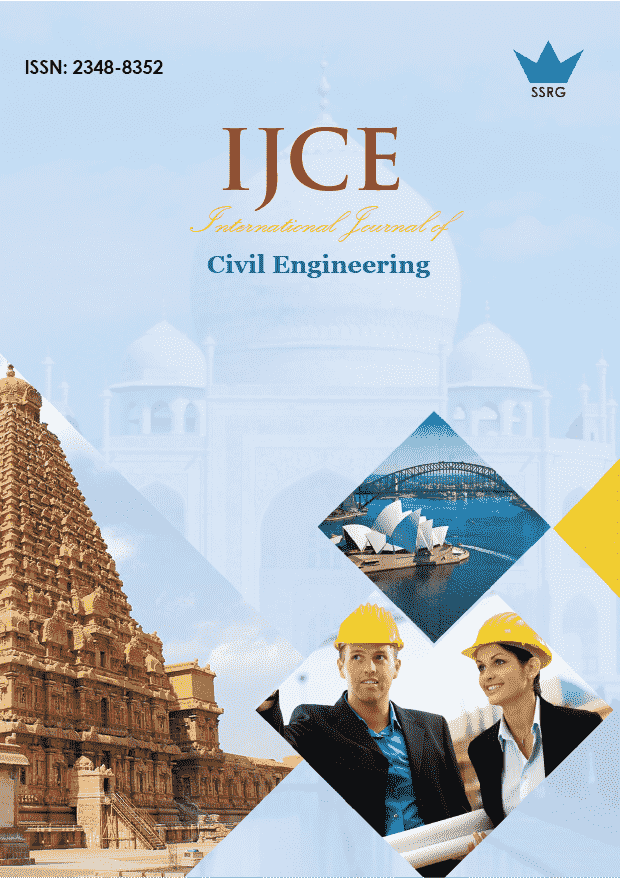Comparative Analysis of Bamboo Poles and Metal Pipes for Hybrid Space Grid Structures: The Case of Vidarbha Region, India

| International Journal of Civil Engineering |
| © 2025 by SSRG - IJCE Journal |
| Volume 12 Issue 5 |
| Year of Publication : 2025 |
| Authors : Rajpal Singh, Kanwaljit Singh Khas, Rupesh Surwade, Abhishek Bangre, Mohammad Arif Kamal |
How to Cite?
Rajpal Singh, Kanwaljit Singh Khas, Rupesh Surwade, Abhishek Bangre, Mohammad Arif Kamal, "Comparative Analysis of Bamboo Poles and Metal Pipes for Hybrid Space Grid Structures: The Case of Vidarbha Region, India," SSRG International Journal of Civil Engineering, vol. 12, no. 5, pp. 11-22, 2025. Crossref, https://doi.org/10.14445/23488352/IJCE-V12I5P102
Abstract:
Space grid structures are preferred, equally, by architects and engineers for their versatility to span, short, medium and large arenas of regular and diverse geometric shapes. Space grid structures are chiefly composed of two components: strut (pipe) and internodes. In the age of sustainability, ways and measures are being employed to include more and more renewable resources in engineering and architecture. For the same reason, eco-friendly hybrid versions of space grid structures are preferred for certain spans and applications. In hybrid bamboo space grid structures, metal pipes (struts) are wholly or partially replaced by nature-grown pipes (bamboos), whereas internodes remain that of mild steel. In space grid structures, as the span increases from short to medium and large, dead load increases, resulting in the usage of high-strength struts and internodes. In factory-made pipes made of mild steel, stainless steel, and aluminium alloy, medium to high strength grades are available. But it is not the same in the case of nature-grown pipes, i.e. bamboo. In bamboo, wall thickness and density vary as per the species of bamboo and also due to variations in climatic conditions. Although bamboo has a tubular hollow section, just like any metal or non-metal pipe, being naturally grown, it has certain uniqueness and limitations. The undertaken research encompasses a comparative study of the physical attributes of factory-made metal pipes and nature-grown pipes (bamboo), especially in the Vidarbha region of the Maharashtra State of India. The research helps strategise and find ways to augment the mechanical strength of bamboo for hybrid bamboo space grid structures.
Keywords:
Augmentation, Bamboo, Metal pipes, Physical Properties, Sustainable Material, Vidarbha, India.
References:
[1] John Chilton, Space Grid Structures, Architectural Press, 1st ed., pp. 1-180, 2000.
[CrossRef] [Google Scholar] [Publisher Link]
[2] N. Subramanian, Principles of Space Structures, Wheeler, pp. 1-666, 1999.
[Google Scholar] [Publisher Link]
[3] Jaime Sanchez-Alvarez, and Herbert Klimke, “The Mero legacy – Inspiring Space Structures Design,” Proceedings of IASS Annual Symposia, IASS 2020/21 Surrey Symposium: Design and Realisation Case Studies, Wurzburg, Germany, pp. 1-12, 2004.
[Google Scholar] [Publisher Link]
[4] United Nations Environment Programme, “2022 Global Status Report for Buildings and Construction: Towards a Zero-Emissions, Efficient and Resilient Buildings and Construction Sector, United Nations Environment Programme, Report, Kenya, pp. 1-101, 2022.
[Google Scholar] [Publisher Link]
[5] Calvin Yap Thai Ming, Wong King Jye, and Haris Ahmad Israr Ahmad, “Mechanical Properties of Bamboo and Bamboo Composites: A Review,” Journal of Advanced Research in Materials Science, vol. 35, no. 1, pp. 7-26, 2017.
[Google Scholar]
[6] Dinie Awalluddin et al., “Mechanical Properties of Different Bamboo Species,” The 6th International Conference of Euro Asia Civil Engineering Forum (EACEF 2017: MATEC Web of Conferences, vol. 138, pp. 1-10, 2017.
[CrossRef] [Google Scholar] [Publisher Link]
[7] N.V. Shende et al., “Economic Analysis of Bamboo Cultivation in Nagpur District,” Journal of Pharmacognosy and Phytochemistry, vol. 10, no. 2, pp. 91-97, 2021.
[Publisher Link]
[8] Jia Feng Song et al., “Bionic Design and Multi-objective Optimization for Variable Wall Thickness tube Inspired Bamboo structures,” Thin-Walled Structures, vol. 125, pp. 76-88, 2018.
[CrossRef] [Google Scholar] [Publisher Link]
[9] Sebastian Kaminski, Andrew Lawrence and David Trujillo, “Structural use of Bamboo. Part 1: Introduction to Bamboo,” The Institution of Structural Engineers,” vol. 94, no. 8, pp. 40-43, 2016.
[CrossRef] [Google Scholar] [Publisher Link]
[10] David Rockwood, Bamboo Gridshells, Routledge Publications, 1st ed., pp. 1-150, 2015.
[CrossRef] [Google Scholar] [Publisher Link]
[11] Vidarbha, Wikipedia, 2011. [Online]. Available: https://en.wikipedia.org/wiki/Vidarbha
[12] MahaSevak, “Assessment of Bamboo Plantations – 2020 in Maharashtra State Promoted by MBDB,” Report, Sevanivrutt Van Karmachari Sangh Maharashtra, Nagpur, pp. 1-50 2021.
[Publisher Link]
[13] Koppen Climate Classification, Earthhow. [Online]. Available: https://earthhow.com/koppen-climate-classification/
[14] Raj Kumar et al., “Seed Source Variation Affects the Growth, Biomass, Carbon Stock, and Climate Resilience Potential: A Case Study of Celtis Australis in Indian Himalayas,” Global Ecology and Conservation, vol. 26, pp. 1-13, 2021.
[CrossRef] [Google Scholar] [Publisher Link]
[15] “Maturity Marking of Bamboo Culms,” National Mission on Bamboo Applications, Report, India, pp. 1-4, 2020.
[Publisher Link]
[16] Clay Bricks Manufacturing, Udyamimitra Portal. [Online]. Available: https://www.udyamimitra.in/index.html
[17] IS 9096, “Preservation of Bamboo for Structural Purposes- Code of Practice,” Report, Bureau of Indian Standards, pp. 1-9, 2006.
[Google Scholar] [Publisher Link]
[18] Niamul Islam, and M.M. Hoque, “Strengthening of Reinforced Concrete Columns by Steel Jacketing: A State of Review,” Asian Transactions on Engineering, vol. 5, no. 3, pp. 6-14, 2015.
[Google Scholar]
[19] Rodolfo Lorenzo, and Leonel Mimendi, “Digitization of Bamboo Culms for Structural Applications,” Journal of Building Engineering, vol. 29, 2020.
[CrossRef] [Google Scholar] [Publisher Link]

 10.14445/23488352/IJCE-V12I5P102
10.14445/23488352/IJCE-V12I5P102